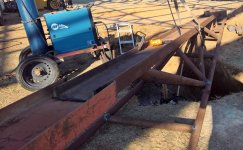OK never being one who can use 5 words to explain something when I can use 100 to completely confuse everyone here goes.
What you say is true to an extent when associated with common solid wire mig welding where the only shielding you have is the gas. Even then you will often find inside fabrication shops the guys will have a fan blowing on them from behind their backs while they are welding fans are nothing more than concentrated winds the guys use their bodies and positioning of their mig guns to block the air currents from the fans plus run a higher flow volume or pressure of the shielding gas to compensate for the blowing air.
Solid mig wire such as E70S6 with CO2 or a mix gas of argon CO2, the most common is mixed as 75/25 but there are others with 3 different gasses such as Argon, nitrogen, CO2, and Oxygen which can be custom mixed and delivered to formulate a specific shielding gas depending on application and specifications to achieve varying tensile, flexibility, and extreme cold or High pressure weld applications.
Then there are the gasless flux cored wires which in recent years have become quite popular in many applications even in some cases being specified for structural applications plus has been successfully utilized in pipeline construction in some cases. I don't care for it all that much but have used many hundred lbs of the stuff.
This brings me to duel shielded welding wire. or FCAW sometimes termed as FCAW-g or simply FCA for short. There are many grades of this just as there are 100s of different stick electrodes specific per application.
What I regularly use is 1 of 3 or 4 brands in the E71T1 class which is closely related to 7018 stick electrodes but has a little better tensile elongation maximum reduction of area and charpe under most conditions and a lot better in a controlled environment.
this is an all position welding filler However I seldom run it downhill when ever I can avoid it, for vertical up or overhead is just like anything else you have to watch the puddle and the freezing of it otherwise you will have a huge glob going down your shirt or pants.
I don't mind welding in 5 to 10 mph breezes outside this is no different than welding in a shop. 10 to 15 MPH wind is about like having a fan somewhere behind you but any wind higher than that you need to grab something to be used as a wind wall to block the wind. So after this all too long of an explanation essentially what I am saying is the welds on the column are probably stronger than anything I could have done using my Lincoln AC welder even if I had used the 7018 rods formulated specially for AC welding which I did use in some areas where it was impossible to position my mig gun.

